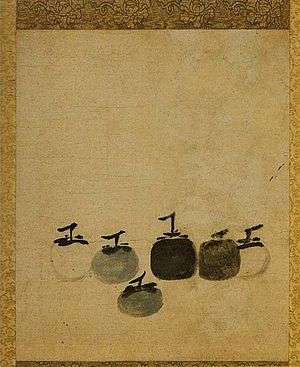Six Persimmons
Six Persimmons (六柿图) is a 13th-century Chinese painting by the monk Muqi Fachang, or Mu Ch'i Fa-Ch'ang. It was painted during the Song dynasty. Muqi was one of the two great exponents of the spontaneous mode of Chinese painting (the other being Liang Kai). It features six persimmons floating on an undefined, but skillfully mottled background. It is painted in blue-black ink on paper.[1]
| Six Persimmons | |
|---|---|
 | |
| Artist | Mu Qi |
| Year | 13th Century |
| Type | Ink on Paper |
| Dimensions | 36.2 cm cm × 38.1 cm cm (14.25 in in × 15 in in) |
| Location | Daitoku-ji, Kyoto, Japan |
The painting became famous for the tremendous skill of the brushstrokes. Their subtlety of modeling is often remarked upon. The thick and thin brushstrokes that model the lightest of the persimmons make it seem to float in contrast to the dark one next to it. The treatment of the stems and leaves recall Chinese characters, and reveal brush control at its highest level.[1] Professor James Cahill of University of California Berkeley devoted an entire lecture to it, available online.[2]
(Six Persimmons is) passion... congealed into a stupendous calm.
It currently resides in the Juko'in subtemple of Daitoku-ji in Kyoto, Japan.[1] It is seldom displayed to the public.
Footnotes
- Lee Page 379-380
- Cahill, James. "12C - Six Persimmons". http://jamescahill.info/a-pure-and-remote-view. James Cahill. Retrieved 8 December 2014. External link in
|website=(help) - Waley page 231
References
- Lee, Sherman E. (1994), A History of Far Eastern Art (5th ed.), Harry N. Abrams Inc., New York, NY
- Waley, Arthur (1923), An Introduction to the Study of Chinese Painting, Benn, London